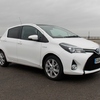This article is more than 1 year old
Toyota Yaris Hybrid: Half-pint composite for the urban jungle
Little mixer won’t excite but it cuts the mustard in the city
Vulture at the Wheel As befits the company most closely associated with the technology, Toyota/Lexus now has a hybrid for you, no matter what size car you're after.
From the medium-sized Auris and Prius to the big hybrid saloons and wagons like the NX300h, it has most of the automotive bases covered.
With the Yaris Hybrid just subjected to a mid-life facelift there is a new petrol-electric runabout for the B-segment customer too.
I have to come clean here and admit that I've never really warmed to the third generation Yaris. The Mk. 1 machine was small and funky, the Mk. 2 bigger but more solid.
However, the current XP130 model always felt a bit like white goods on wheels: just a bit too forgettable both to drive and to look at.
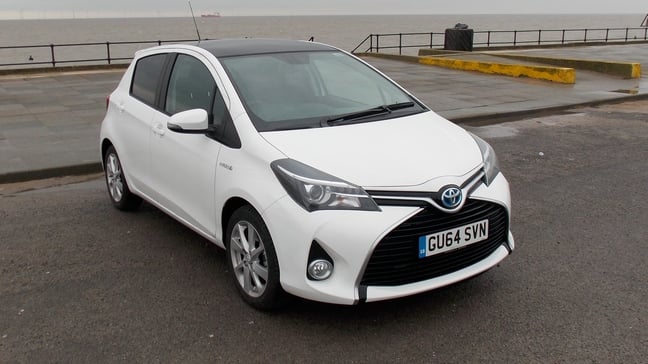
The new Yaris Hybrid looks a lot like the new Aygo from the front. No bad thing
The new facelift hasn't turned the Yaris into a beauty but at least the new nose is distinctive. There’s now a strong family resemblance to the new Aygo, and the Aygo’s looks are without doubt the best thing about it.
Powering the Yaris Hybrid is a 1.5L, four-cylinder Atkinson cycle petrol engine and a 45kW (59bhp) electric motor that draws its power from a 0.9kWh nickel metal-hydride battery. If that all sounds a vaguely familiar it’s because it’s an updated version of the hybrid powertrain used in the second generation Prius.
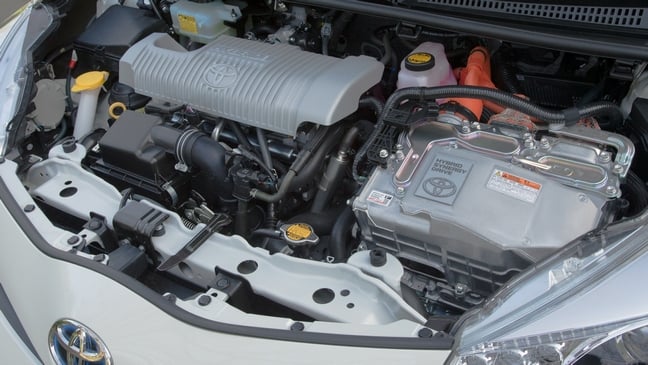
Yaris Hybrid rocks a drivetrain carried over from the 2nd Gen Prius
As with all Toyota and Lexus hybrids the Yaris combines its electric motor with a planetary gearset which work together in a way that feels like a continuously variable transmission.
There’s no traditional CVT belt involved but as far as the driver is concerned the end result is much the same: the engine revs, the transmission and car catch up. Hence Toyota’s E-CVT moniker.
As hybrid systems go it gives the Yaris a big advantage over its only class competition, the Honda Jazz with its Integrated Motor Assist hybrid system. The Yaris, like all its stablemates, can run on battery power alone. Granted only for a little more than a mile and only at speeds below about 20mph, but that’s better than nothing.
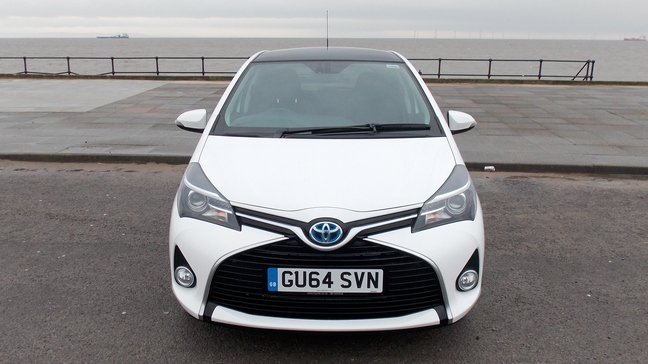
New nose job makes Yaris look permanently angry. Grrrrr....
At low speeds the move from electric to petrol power is a commendably subtle. If you have stereo turned up to anything beyond whisper and don’t accelerate too harshly you can’t always tell when the 4-pot has fired up. As with most hybrids the availability of instant electric power means the engine management system cuts out the petrol motor whenever possible. It’s stop/start but writ large.
With a combined system power output of 98bhp (75kW) the Yaris was never going to feel fast and it doesn’t. Jump on the go pedal and you will see 62mph in a lethargic 11.8 seconds and run out of puff at 103mph. At speeds above 65mph the acceleration feels worse than those number suggest. Glacial is a kind way to describe it.
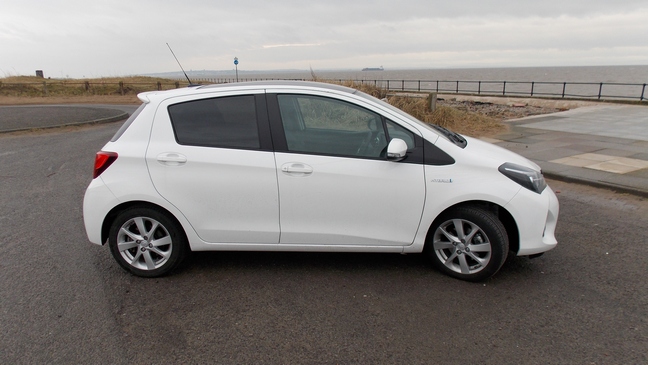
From all directions bar head on the new Yaris is still a bit too anonymous for my taste
High speed performance isn’t helped by the aerodynamics. The Yaris Hybrid records the same drag coefficient (0.29 since you ask) as the rest of the range.
Around town, which is the Yaris Hybrid’s natural habitat, it’s a happier story. Thanks to the electric motor’s 169Nm (125lb-ft) of torque the little Toyota will scoot away from the lights briskly and quietly. If you are tootling around town in heavy traffic at speeds below 40mph it really is a nice little wagon. Eager, refined and an absolute piece of cake to drive.

Yaris Hybrid aces the Register's "Can you get a Norwegian Elkhound in the back?" test
Despite the parts-bin drivetrain the Yaris was always designed to be a hybrid which has paid dividends when it comes to packaging. The battery and all associated gubbins are tucked away under the back seats.
That means the Yaris Hybrid offers exactly the same cabin and luggage space as the rest of the range. On fact the only real physical difference is the weight - the hybrid car is 60kg heavier than the diesel model, 100kg heavier than the 1.0L petrol. The drive battery accounts for 31kg of that.
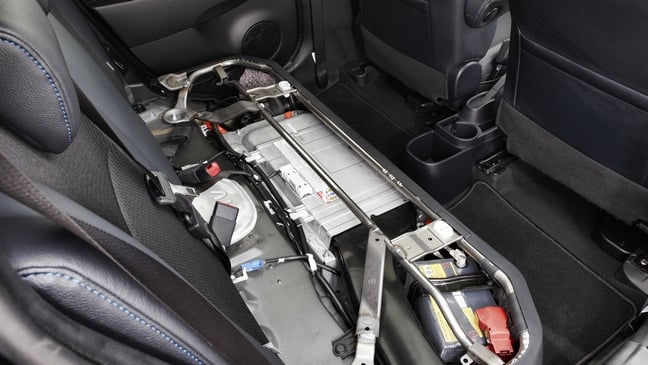
Hybrid battery cleverly tucked away under the back seats
Toyota could have been braver in the cabin. While the Prius’ cabin tries too hard to be sci-fi slick the Yaris, like the Auris, goes too far the other way. There is actually so little difference between the dash of the hybrid and non-hybrid versions that you could be forgiven for forgetting which one you are driving.
I can understand why Toyota has done this. Its buyers are a generally conservative bunch and a dash full of LED lighting and graphics would likely not only scare the horses but give some of them a heart attack.
But at least a little more pizzazz in the cabin would have been welcome.
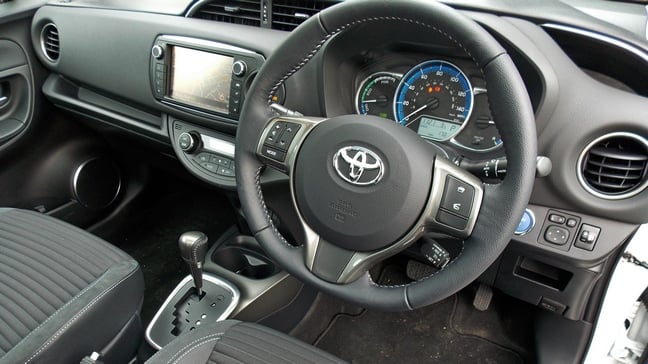
Cabin is frankly a little dull for a 'leccy car. Horses not frightened
The one major difference is that the rev counter has been replaced by a battery dial that swoops between Charge, Eco and Power. The only other clues to the hybrid powertrain are the two buttons next to the handbrake for selecting Eco and EV modes.
The EV button does what you’d expect and sticks the Yaris into electric-only drive. Eco mode dials back throttle inputs and minimizes the power draw from the climate control system. A third driving mode can be entered by snicking the gear selector down from D-for-drive to B-for-brake. This increases the aggression of the regenerative braking.
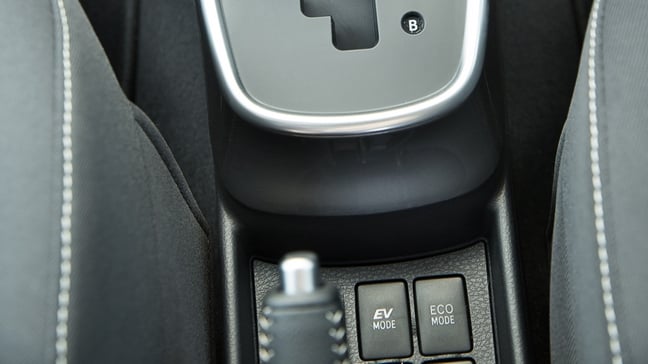
B-for-Brake gear selector and EV and Eco buttons mark this Yaris as a hybrid
It is actually somewhat surplus to requirement since the Yaris has an inherently efficient kinetic energy recovery system. Even after deliberately depleting the battery with over zealous use of the EV button I was continually surprised at how fast it recharged. The Brake position is really only of use if you are driving down a very long, very steep hill.
Fuel economy depends on what you use the Yaris for. Out on the open road I was getting between 50 and 60mpg, which is acceptable (but no more than that) from a car pitched as an out-and-out fuel saver. In town I got very close to 70mpg which was altogether more impressive.
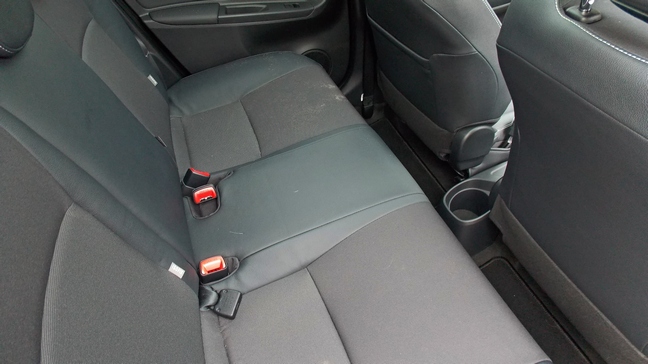
Yes you are sitting on a big battery, but there's still plenty of room
If I’d made even more use of the EV button (you really should be able to activate EV mode from a button of the steering wheel rather than have to grope around by the handbrake) I could possibly have bettered that. In stop-start urban traffic you just can't beat an electric motor as an economical way of powering a car.
Incidentally, Toyota’s claimed MPG figures are 91.1mpg urban, 85.6 extra-urban and the same combined. You’d have to drive very, very thoughtfully (and I suspect with a tail wind) to get close to those figures. Claimed CO2 emissions are 75g/km.
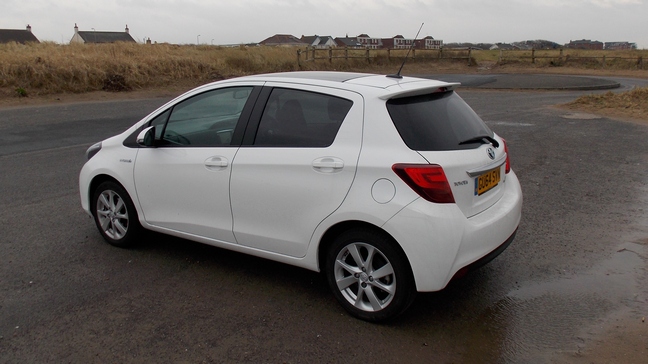
Badges aside, the Hybrid looks the same as the rest of the range. Same drag coefficient too
How does the Yaris drive? Competently, in a word. If you want fun buy a Ford Fiesta. The Toyota is pretty refined wagon though thanks to slightly re-calibrated suspension to deal with the extra weight of the hybrid system and the silent, vibration-free power of the electric motor.
If I was faced with a tough, daily urban commute I reckon the Yaris Hybrid could be just the tool for the job.
The Yaris Hybrid range starts at £16,195 which is only £600 more than the same specification diesel model. The top of the range version will set you back £17,595. Or, £20,185 if you include the fancy pearlescent paint job, MirrorLink-enabled Touch2 with Go system and Design and Appearance packs my test car came bundled with. That makes the Yaris the cheapest hybrid in the UK; Honda wants a minimum of £17,150 for its Jazz Hybrid.
The Reg Verdict
It’s difficult to get really excited about the Toyota Yaris just as it is to get excited about a Bosch fridge freezer. Both do what they do without drama and do it reliably. But also without much excitement or flair.
To be fair though the new Yaris is the cheapest hybrid you can buy in the UK and around town it’s economical, refined and very easy to pilot.
In its latest incarnation it looks more distinctive too. Out on the open road a diesel Fiesta or Polo would be a better bet, but the Yaris Hybrid has its place in the overall scheme of things and isn't without merit. ®
